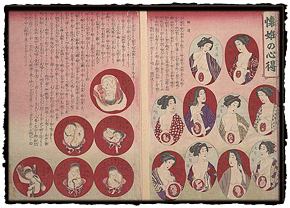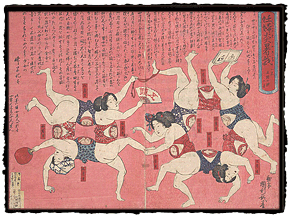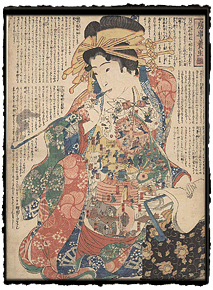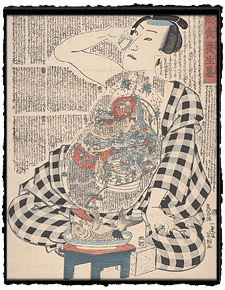Women's Health
by Laura W. Allen
A number of the prints
in the collection deal with women's health, including some vivid depictions of
pregnancy. At the beginning of the Meiji era, the bunmei kaika, or "civilization and
enlightenment" movement, introduced a
more scientific outlook in many areas
of Japanese life, including attitudes toward pregnancy and childbirth. Anatomical drawings from the West, available
widely for the first time, provided models for the representation of such
themes as the stages of fetal gestation.
 A diptych from 1880,
titled "Information on Pregnancy," demonstrates how those models were adapted
for the Japanese audience. In the right half of the print are ten
egg-shaped portraits of women in various stages of pregnancy. Their open robes reveal a cut-away view of
the uterus, with the fetus floating against a red background. Counted from conception forward, they are
labeled as views of the ten months of pregnancy. A diptych from 1880,
titled "Information on Pregnancy," demonstrates how those models were adapted
for the Japanese audience. In the right half of the print are ten
egg-shaped portraits of women in various stages of pregnancy. Their open robes reveal a cut-away view of
the uterus, with the fetus floating against a red background. Counted from conception forward, they are
labeled as views of the ten months of pregnancy.
In a set of five red
spheres at the left are the different presentations at delivery: at top, in a
slightly larger circle, is the typical cephalic (head-first) presentation,
followed by shoulder presentation (the arm emerges first), multiple birth
(twins), footling breech, complete breech, and the delivery of a breech
baby. Prints like these must have
created quite a sensation when they were produced, providing as they did the
latest, up-to-date scientific information.
 "Pregnant women playing in summer heat
- 5 heads with 10 bodies" is the title of another, more entertaining image of
the stages of fetal development by Utagawa Kunitoshi (1847-1899). At first glance, it appears that this group
of pregnant women is performing acrobatics in the nude; with the exception of a
sash tied around the midriff of each woman, they are naked, though their
genitals and breasts are artfully concealed. "Pregnant women playing in summer heat
- 5 heads with 10 bodies" is the title of another, more entertaining image of
the stages of fetal development by Utagawa Kunitoshi (1847-1899). At first glance, it appears that this group
of pregnant women is performing acrobatics in the nude; with the exception of a
sash tied around the midriff of each woman, they are naked, though their
genitals and breasts are artfully concealed.
Upon closer inspection, one realizes
that each head is attached to two bodies, and that the bodies are cleverly
linked so that the lower bodies each appear to be shared by two women. Connecting these
shared heads, arms, buttocks, and legs are ten torsos, each revealing an image of a growing
fetus. The fan held by the woman at center says "five heads," and the abdomens are labeled from
the first to the tenth month. Above the women is written further information about the course of
pregnancy.
 A print dating from the mid-1850s shows the internal
workings of a woman's body as a kind of Rube Goldberg apparatus operated by a
host of tiny female workers. This
imaginative rendering is titled "Dietary Advice for a Good Sex Life," and the
woman is not a housewife but a geisha in full regalia: an elaborate coiffure
spiked with a dozen large hairpins and combs, and a brilliantly patterned robe
over the requisite, provocative red undergarment. She is smoking a long pipe,
her left hand clutching a wad of tissues atop a black and gold lacquer smoking
box. A print dating from the mid-1850s shows the internal
workings of a woman's body as a kind of Rube Goldberg apparatus operated by a
host of tiny female workers. This
imaginative rendering is titled "Dietary Advice for a Good Sex Life," and the
woman is not a housewife but a geisha in full regalia: an elaborate coiffure
spiked with a dozen large hairpins and combs, and a brilliantly patterned robe
over the requisite, provocative red undergarment. She is smoking a long pipe,
her left hand clutching a wad of tissues atop a black and gold lacquer smoking
box.
 Another
print, titled "Model for a Healthy Diet," represents a man's body in the same
manner, although male laborers occupy his gut.
Presumably he too is a habitué of the pleasure quarter, as he is shown
partially unclothed, a sake cup lifted to his mouth, and a carp, a symbol of
virility, set out on a porcelain dish before him. Two related prints use the same cut-away
perspective to portray a man's internal functions, as dramatized by kabuki actors. Another
print, titled "Model for a Healthy Diet," represents a man's body in the same
manner, although male laborers occupy his gut.
Presumably he too is a habitué of the pleasure quarter, as he is shown
partially unclothed, a sake cup lifted to his mouth, and a carp, a symbol of
virility, set out on a porcelain dish before him. Two related prints use the same cut-away
perspective to portray a man's internal functions, as dramatized by kabuki actors.
|
|
|

